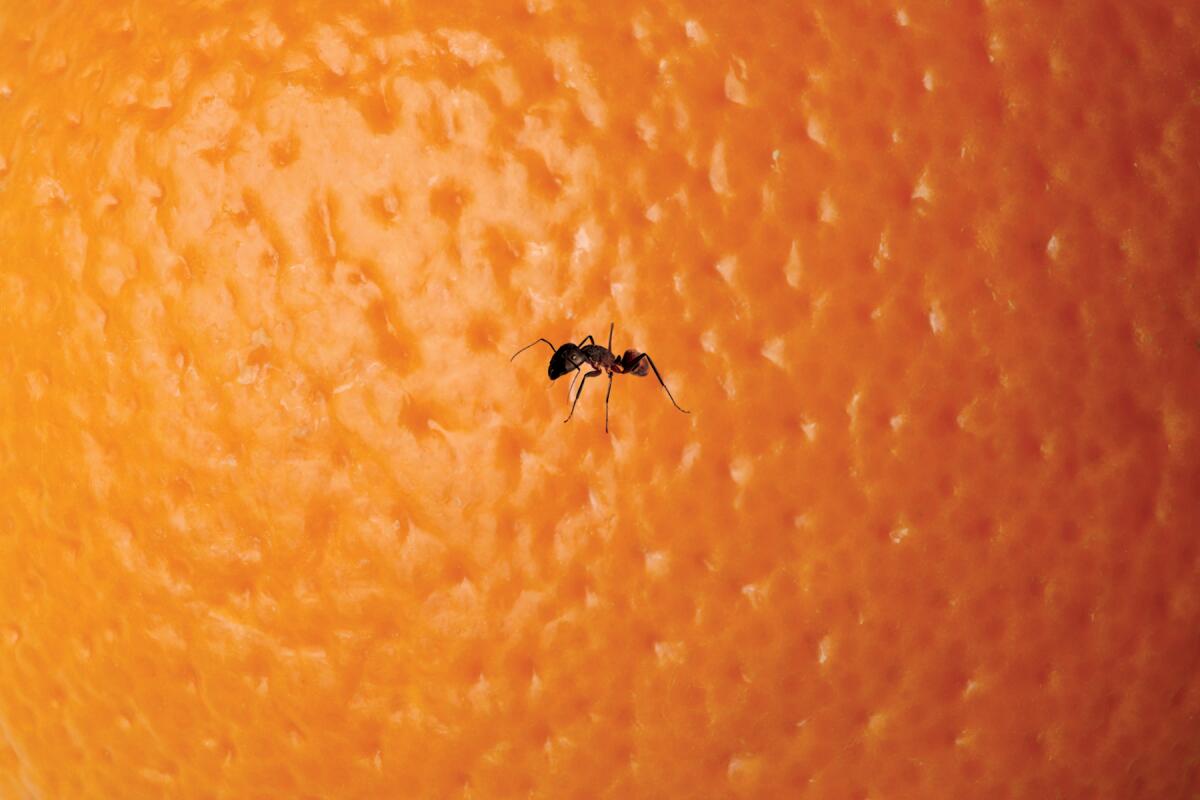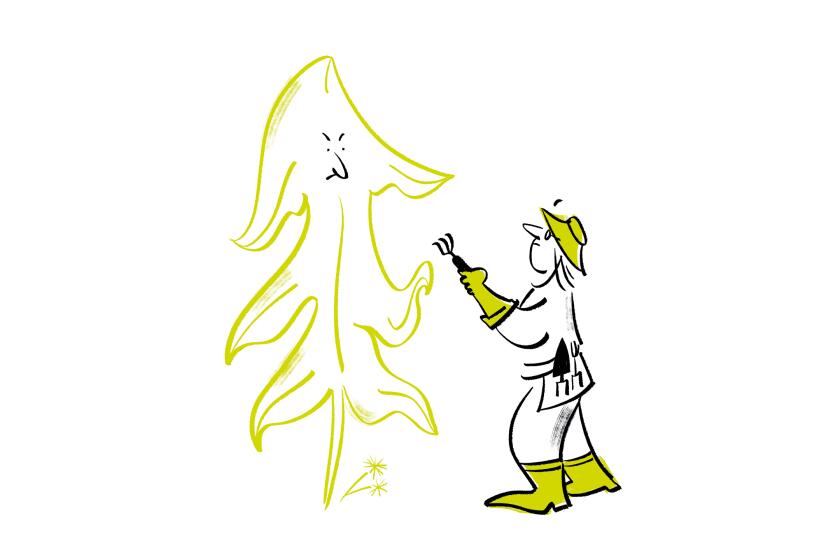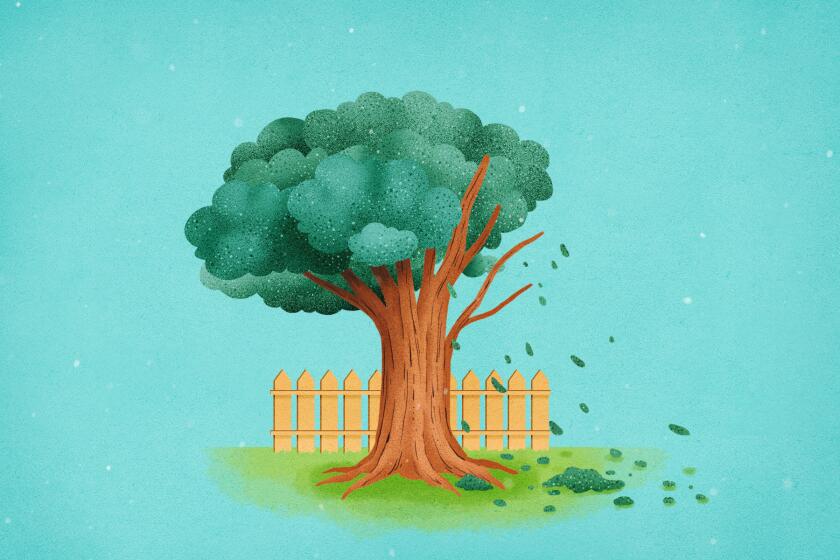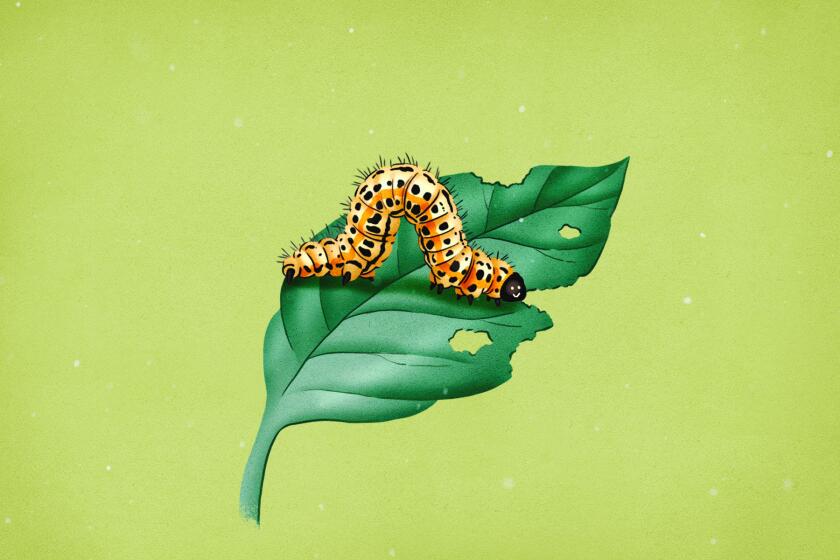Want to save your citrus trees? Start a full-fledged insect war

Growing citrus is a dicey business these days in Southern California, and not at all recommended if you live within a two-mile radius of a tree infected with Huanglongbing — a.k.a. HLB or citrus greening disease. However, if you live outside a “red zone” and you’re willing to actively fight the disease, then yes, it’s still possible to grow limes for your margaritas.
But you’ll have to be ruthlessly proactive by declaring brutal warfare on the ants in your yard while embracing a tiny parasitoid wasp that eats its living prey from the inside out.
Gardeners, take a deep breath. We’ve made a list of 10 garden tasks that can help save your sanity now and make the coming months much more pleasant.
HLB is a bacterial disease spread by the tiny Asian citrus psyllid that loves to suck the sap from tender new “flush” growth on citrus and then lay its eggs. If the psyllid sups on a tree with HLB, it spreads the disease to every other tree it visits, and once infected, there is no cure.
The University of California’s department of Agriculture and Natural Resources has created an interactive map that identifies hot zones of infection: in Southern California they’re mostly in the four-corners area where Los Angeles, Orange, Riverside and San Bernardino counties meet. Enter your address and it shows how close your home is to those infection areas.
It’s time to stop wringing your hands over COVID-19: Plant some food and create your own victory garden. Here are eight steps to get started.
For those in the red circle — within two miles of a hot zone — the advice is to remove your citrus trees and not plant any others until researchers find a cure. In the yellow circle — within two to five miles of a hot zone — the advice is to “consider replacing your tree with a non-citrus fruit tree” or protect your citrus trees with industrial-strength insecticides, which devastate honeybees, and complicated-to-use fine-mesh netting.
In citrus-loving California, some 60% of homes already have one or more citrus trees in their yard, said UC Riverside entomologist Elizabeth Grafton-Cardwell, director of the Lindcove Research and Extension Center in Exeter. (That’s a statewide average, with fewer in Northern California and more in Southern California, she said.)
How to know if the tree in your yard is sick or dying, and how to deal with it.
But many homeowners treat their citrus like any other tree, which means they basically ignore them, she said.
“When we first started this program back in 2012, I was encouraging Master Gardeners to teach homeowners how to treat their trees [to discourage psyllids],” she said, “but the complaint came back from the Master Gardeners, ‘I treat my trees but none of my neighbors do, so what’s the point?’”
The threat is serious: HLB disease devastated Florida’s citrus industry when it hit in 2005, destroying half of its acreage and production, and pretty much eliminating residential citrus, Grafton-Cardwell said. Which is why California’s $1.7-billion citrus industry is willing to do whatever it takes to destroy the psyllids, such as spraying the trees with industrial-strength pesticides — pyrethroids and neonicotinoids — that are toxic to bees. Grafton-Cardwell sees it as a necessary evil to eradicate a terrible disease and then reintroduce the bees later.
The best pest control is keeping your plants well-fed and hydrated. Here’s how to treat and prevent pest outbreaks.
But Mark Hoddle, a biological control specialist at UC Riverside, sees things differently. Hoddle and his entomologist wife, Christina Hoddle, also at UC Riverside, went to Pakistan in 2010 looking for natural enemies of the Asian citrus psyllid, and there they found Tamarixia radiata, tiny parasitoid wasps that lay their eggs on the backs of psyllid toddlers (a.k.a. nymphs). Once those wasp eggs hatch, the baby wasps burrow inside the nymphs and devour them from the inside out, leaving only a hollow husk.
Not pretty but very effective. The couple brought the wasps back to California and released them in 2011, and they have thrived. “They’re basically everywhere now” in Southern California, Hoddle said, and he believes they are responsible for flattening the HLB infection rate, much as staying at home is supposed to flatten COVID-19 infection rates in California.
“We’ve had psyllid here [in California] since 2008, but we still have a lot of oranges,” Hoddle said. “The disease hasn’t swept through California the way it did through Florida, and I believe our biological control program is why. Psyllid populations have decreased by 70% to 80% since our first parasite release in 2011. We haven’t wiped out HLB in citrus trees, but we have mitigated the risk.”
Hoddle himself lives within two to five miles from a hot zone infection area in Riverside, but he still has some citrus trees in his yard, including a recently planted lime tree.
The trick, he said, is to be proactive about keeping psyllids away. That means searching new “flush” citrus growth for psyllids, planting alyssum — a tiny-flowered ground cover that parasitoid wasps love — and declaring open warfare on the ants in your yard, who tend and protect sap-sucking insects like psyllids so they can collect the sugary sweet “honeydew” the nymphs excrete that looks like tiny white toothpaste coils escaping from a tube.
In other words, the ants are doing everything they can to support the psyllids you want to keep away, and will fiercely attack the wasps if they find them around their psyllid flock. So, bottom line, Hoddle said: “Controlling the ants is the most important thing you can do.”
Here are three tips for saving your citrus trees:
1. Search for psyllids
UC Riverside has a video that explains ways to search for the psyllids on your trees. Concentrate your search on the tree’s tender new growth — the psyllids won’t eat older wood or leaves.
2. Kill the ants
If you see ants streaming up and down your citrus trees, that’s a sign that they’re tending some kind of sap-sucking pest, Hoddle said. The trick is using a bait that will slowly kill the ants, over a period of days, allowing the workers time to bring the bait back to the nest where it will be consumed by the queen and others. If the poison is too strong, it will kill the ants before they get back to the nest, Hoddle said. He recommends buying refillable liquid ant bait dispensers, such as these produced by KM Ant Pro, and mixing your own ant bait: Mix 1 cup of sugar, 3 cups of water and about 1 teaspoon of high-purity (99%) water-soluble boric acid. The mixture is relatively safe to humans and animals “unless you drink 50 gallons of the stuff,” Hoddle said, but “phenomenal at ant control.”
Hoddle notes that 1 teaspoon is about 5 grams of dry material or about 5 milliliters of wet material. If in doubt use less rather than more, he said, to make sure the poison is dispersed throughout the colony, especially to the queen, before the ants die. “It may take two to three days of feeding, when you get lots and lots of ants at the feeder, but you want them to keep taking it back and taking it back to the nest, until the toxins reach the critical level and then they’ll all die about the same time.”
3. Plant alyssum
Once you’ve tamed the ants, parasitoid wasps will be able to do their work without interruption, Hoddle said, but you need to entice them into your yard by planting sweet aylssum (Lobularia maritima), a sweet-smelling, tiny-flowered ground cover that provides the nectar and pollen parasitoids and other beneficial insects love. Alyssum thrives in full sun, as long as it gets an inch or so of water once a week in well-drained soil. (The plant can rot if the soil stays wet.) Hoddle plants them in pots around his trees, but you can also plant them in the ground or at the edge of rock walls, where they spill prettily over the sides. The plants are readily available in nursery six-packs, but they also grow easily from seed.
You won’t see the wasps. They’re about half the size of ants, but the flowers will draw them in, Hoddle said. “You don’t need a lot; just a couple of pots will provide a lot of food for natural enemies [of psyllids]. That’s what I do around my house. I’m expecting to get the best harvest I’ve ever had from my lime tree, and I have no pests on my trees.”
Just remember, Hoddle’s biological controls require diligence. If you’re up to the task and live outside a red circle, go ahead and plant some citrus. If not, plant some other non-citrus fruit tree. There are many delicious varieties out there, and you can enjoy them without threatening other citrus.
More to Read
Sign up for The Wild
We’ll help you find the best places to hike, bike and run, as well as the perfect silent spots for meditation and yoga.
You may occasionally receive promotional content from the Los Angeles Times.















